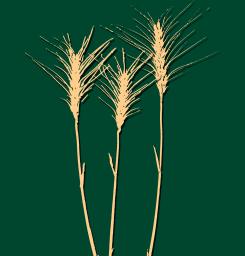When people hear that I make virtually all our bread, they nod in approval and invariably ask what kind of bread machine I have. Here is how the conversation generally continues:
Me: No, I make it by hand. I don't have a bread machine.
They: No bread machine??
Me: No, all by hand.
They: (awestruck) Wow... that must be hard... and take a long time...
Me: No, not at all!
They: (incredulous) ...really?
Yes, I always knead by hand (except once when I made the mistake of using our food processor to make
$35 bread ...not a good idea...). The choice to hand-knead is not necessarily because I'm a luddite. I just don't happen to have an electric mixer large enough to accommodate the amount of dough. And I'm too cheese-paring with counter space (and my wallet) to get one. Besides, it's much easier to wash my hands than it would be to wrestle with a mixer to take it apart, clean off sticky dough and then wrestle it into its storage area.
When I first started baking bread on a regular basis, my favourite book was The Italian Baker by Carol Field (it's still one of my favourite books...). In almost every recipe, Field has instructions for preparing dough by hand, by food processor, by electric mixer. But for one of the rustic breads in her book, pane Pugliese (p.122), Field suggests not to even try to knead by hand as it's just too sloppy. Don't even try?? But we WANTED that bread!! We NEEDED that bread!! (no no, don't worry. I won't say it... I just can't bring myself to say "so I knea...")
So I took the plunge and started hand kneading even the slackest of dough. Not only was it exhiliariarating, but it worked out just fine. More than fine. That bread is one of our favourites.
And then T gave me Maggie Glezer's wonderful book Artisan Baking Across America, in which she describes a fantastic way to deal with slack dough (Acme's Rustic Baguettes). She suggests to knead for a short time initially, let the dough autolyse and then finish developing the dough by stretching and folding three times after the initial kneading. The method is slightly more time consuming because you have to be available to do the stretching and folding. But it makes hand-kneading slack dough much much easier AND the resulting bread turned out better too.
I use Glezer's method to knead all slack doughs now, including the wild yeast bread I have just recently started making.
Anyone who has hand-kneaded regular bread dough would agree that it's pretty easy to knead using only your hands. But slack dough requires a slightly different trick. And it isn't as difficult as it might seem....
Use a wooden spoon to stir the wet dough until it looks like porridge; cover the bowl and let it rest for about 20 minutes to allow the dough to autolyse*. Scatter a dusting of flour on the board (I use a flour wand) and pour the dough onto the board. Don't worry that it still looks like porridge. Wash and dry the rising bowl.
A dough scraper is very helpful - read "essential" - when kneading slack dough. Use it to clean the board, fold the dough in half and give it a quarter turn as best you can. Use your other hand to stretch the dough upwards, give it a twist as you are lowering the dough and using the scraper to turn the slop over. A big advantage is that the hand holding the scraper stays quite clean. (And if you put a tea towel under the board, the board won't slip around on the counter.)
Slack dough still resembles porridge after hand-kneading for 5 to 10 minutes. Fear not. Just use the dough scraper to maneuvre the sloppy mess into your clean rising bowl (please do not oil the bowl; it is unnecessary). Scrape your hand off as best you can and cover the bowl. Let it rest on the counter for 20 to 30 minutes. (Note how the dough scraper has pretty much completely cleaned the board.)
After the dough has rested, it's time for its first turn. From now on, your motto should be "gently, gently".
Scatter a dusting of flour on the board (I use a flour wand) and pour the dough onto the board. Don't worry that it still looks like porridge. Wash and dry the rising bowl.
Slip the dough scraper under the right side of the dough in preparation for gently folding the dough in half. After it is folded, gently pat away any excess flour. Slip the dough scraper under the bottom side of the dough in preparation for gently folding the dough in half again. Fold and continue to the left and top of the dough. (four folds) Use the dough scraper to maneuvre the dough back into the clean rising bowl. You'll see that it looks a little less porridge-like and that the dough scraper has pretty much cleaned the board. Cover the bowl and let the dough rest in a draft-free area on the counter for another 20 to 30 minutes.
After the dough has rested, it's time for its second turn. Scatter a dusting of flour on the board and pour the dough onto the board. You'll see that it already looks less like porridge.
Wash and dry the rising bowl.
Gently fold the dough in the same way as before starting at the right side and working around all four sides. Gently pat the excess flour off. Put the folded dough back in the clean rising bowl to rest for another 20 to 30 minutes.
One more time, after the dough has rested, it's time for its third turn. Scatter a dusting of flour on the board and pour the dough onto the board. It is still quite loose but looks much more like dough. Note how the dough just pulls away from the bowl as you pour it onto the board. If it sticks, use a (clean) finger or rubber scraper to gently pull the dough out onto the board. Wash and dry the rising bowl.
Gently fold the dough in the same way as before starting at the right side and working around all four sides. Once again, gently pat the excess flour off.
By now the dough will look smooth but will still be quite soft. Use the dough scraper to gently put the dough back into the clean rising bowl (you really don't want to disturb the bubbles that are beginning to form). Cover and allow it to rise in a draft-free area on the counter to about double (another couple of hours or so, depending on the temperature of the kitchen).
Once the dough has doubled, gently (but I didn't really have to say "gently" again, did I?) release the risen dough onto the, this time, generously floured board. Use the dough scraper to divide the dough into two and shape into two rounds. Place on parchment paper covered peel. Placing cookie cutters on the shaped dough as it is rising etches a design on top of the bread. Flour the rounds and cover with plastic. The cookie cutters also help to keep the plastic from sticking to the dough. Allow to rise in a draft-free area on the counter til just doubled.
When the shaped bread has doubled, liberally spray with water and bake at 400F in a preheated oven for 40 to 50 minutes. To make sure the bread is fully baked, check that the internal temperature of the bread is 210 to 220F - around 100C. (I use a meat thermometer.) Place the baked bread on a footed rack and allow to cool completely before cutting. The bread continues to cook as it cools.
* According to Merriam Webster, autolyse (also autolyze) is "to undergo autolysis". And autolysis?
autolysis [...] breakdown of all or part of a cell or tissue by self-produced enzymes -- called also self-digestion
On answers.com, there is an entry from Food and Nutrition (Oxford University Press):
autolysis The process of self-digestion by the enzymes naturally present in tissues. For example, the tenderizing of game while hanging is due to autolysis of connective tissue. Yeast extract is produced by autolysis of yeast.
And here is what Wikipedia has to say:
Autolyse is a period of rest allowed for dough to relax. After the initial mixing of flour and water, the dough is allowed to sit. This rest period allows for better absorption of water and allows the gluten and starches to align. Breads made with autolysed dough are easier to form into shapes and have more volume and improved structure.
And finally, in Artisan Baking Across America, Maggie Glezer wrote:
The term autolyse [...] was adopted by Professor Raymond Calvel, the esteemed French bread-baking teacher and inventor of this somewhat odd but very effective technique. During the rest time, the flour fully hydrates and its gluten further develops, encouraged by the absence of: compressed yeast, which would begin to ferment and acidify the dough (although instant yeast is included in autolyses lasting no longer than 30 minutes because of its slow activation): salt, which would cause the gluten to tighten, hindering its development and hydration; and pre-ferments, which would also acidify the dough. The flour's improved hydration and gluten development shorten the mixing time, increase extensibilty (the dough rips less during shaping), and ultimately result in bread with a creamier colored crumb and more aroma and sweet wheat flavor.
(edited 2 October 2007 to fix spelling error)
















